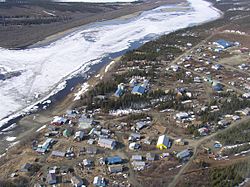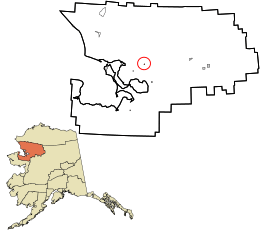Kiana, Alaska facts for kids
Quick facts for kids
Kiana
Katyaaq
|
|
|---|---|

Aerial view of Kiana and the Kobuk River
|
|

Location in Northwest Arctic Borough and the state of Alaska
|
|
| Country | United States |
| State | Alaska |
| Borough | Northwest Arctic |
| Incorporated | June 30, 1964 |
| Area | |
| • Total | 0.19 sq mi (0.49 km2) |
| • Land | 0.19 sq mi (0.49 km2) |
| • Water | 0.00 sq mi (0.00 km2) |
| Elevation | 92 ft (28 m) |
| Population
(2020)
|
|
| • Total | 447 |
| • Density | 2,377.66/sq mi (917.66/km2) |
| Time zone | UTC−9 (Alaska (AKST)) |
| • Summer (DST) | UTC−8 (AKDT) |
| ZIP code |
99749
|
| Area code | 907 |
| FIPS code | 02-39300 |
| GNIS feature ID | 1413311 |
Kiana (which means Katyaak or Katyaaq in the Iñupiat language) is a small city in Northwest Arctic Borough, Alaska, United States. In 2010, the city had 361 people living there. By 2020, the population grew to 447.
Contents
History of Kiana
Life Before Contact
Kiana was founded many centuries ago. Its name means "where three rivers meet." Long ago, the Inupiat people who lived here moved around a lot. They followed animal herds to hunt for food and furs.
In the 1800s, the Inupiat people of Kiana lived along the Kobuk River. They hunted and fished near their homes all year. They would move to places where there were lots of animals and fish. Their homes were made of sod (earth and grass).
If someone died inside a house, they would leave it. They believed they might catch a sickness if they stayed. Instead of burying people in coffins, they wrapped bodies in cloth. They would then set up poles to make a teepee shape over the body.
Scientists have studied an old site nearby called 'Igliqtiqsiugvigruaq'. This means "Swift Water Place." Ancestors of Kiana's people lived there from 1790 to 1810. This old town had homes dug into the ground, connected by tunnels.
Early 1900s Changes
The first white people arrived in Kiana by boat in 1898. Their arrival changed the way of life for the Inupiat people. More people came in 1901 and 1902 and started building houses. Some Inupiat women married these new men.
Archaeologists found an even older Inupiat village near Kiana. They used carbon dating to find out it was from the late 1700s to early 1800s. They found that some of the houses were connected by tunnels. These houses were about the size of a typical one-room cabin. They also found old metal pieces and glass beads.
Kiana became an important village for the Kowagmiut Inupiaq Eskimos living along the Kobuk River. The U.S. government noticed Kiana as its population grew. It officially became a city in 1915. A United States Post Office was built in 1964.
Before the post office, mail came only once a month. It was delivered by dog sled or by people walking between villages. During this time, Kiana was a key place for supplies. It helped coal and gold miners working along the Squirrel River. The Blankenship Trading Post was the only store. It sold important goods like flour, salt, coffee, sugar, and canned fruits.
Language of Kiana
The villages of Ambler, Shungnak, and Kobuk were the first to teach the Inupiaq language in public schools. Other villages, like Noorvik and Kiana, soon followed. Viola Barr and Rosaline Jackson were the first teachers of Inupiaq in a Kiana classroom in 1971.
Before white people came, children in Kiana grew up speaking Inupiaq. Today, most students and adults in Kiana do not know how to read, write, or speak the language. People in the region are working hard to help more townspeople learn Inupiaq again. Programs like Rosetta Stone and the Inupiaq Language Commission are helping with this effort.
Geography of Kiana
Kiana is located at 66°58′18″N 160°25′49″W / 66.97167°N 160.43028°W. It covers about 0.2 square miles (0.49 square kilometers) of land.
The village of Kiana is special because it sits where three rivers meet: the Squirrel River, the Kobuk River, and other smaller channels. Kiana is in Northwestern Alaska, about 30 miles north of the Arctic Circle. It is also about 57 air miles east of Kotzebue.
Climate in Kiana
Kiana often has strong storms and big changes in temperature. There is also proof that the climate has been changing over the last 50 years. Records show that temperatures are rising each month. Also, there is more rain and snow, except in July.
Kiana gets a lot of snow, about 60 inches (152 cm) each year. The average rainfall is about 16 inches (41 cm). The Kobuk River can be used by boats from May to October. For the rest of the year, the river is frozen solid.
| Climate data for Kiana, Alaska | |||||||||||||
|---|---|---|---|---|---|---|---|---|---|---|---|---|---|
| Month | Jan | Feb | Mar | Apr | May | Jun | Jul | Aug | Sep | Oct | Nov | Dec | Year |
| Record high °F (°C) | 40 (4) |
38 (3) |
48 (9) |
62 (17) |
82 (28) |
92 (33) |
91 (33) |
91 (33) |
74 (23) |
62 (17) |
41 (5) |
42 (6) |
92 (33) |
| Mean daily maximum °F (°C) | 4.6 (−15.2) |
10.3 (−12.1) |
16.1 (−8.8) |
33.4 (0.8) |
51.5 (10.8) |
65.4 (18.6) |
67.5 (19.7) |
61.3 (16.3) |
50.1 (10.1) |
31.0 (−0.6) |
11.3 (−11.5) |
6.7 (−14.1) |
34.1 (1.2) |
| Daily mean °F (°C) | −2.3 (−19.1) |
2.3 (−16.5) |
6.7 (−14.1) |
23.6 (−4.7) |
41.5 (5.3) |
54.9 (12.7) |
58.2 (14.6) |
52.4 (11.3) |
41.9 (5.5) |
25.0 (−3.9) |
5.9 (−14.5) |
0.3 (−17.6) |
25.9 (−3.4) |
| Mean daily minimum °F (°C) | −8.6 (−22.6) |
−5.1 (−20.6) |
−3.6 (−19.8) |
13.6 (−10.2) |
31.5 (−0.3) |
44.3 (6.8) |
48.8 (9.3) |
43.5 (6.4) |
33.6 (0.9) |
18.9 (−7.3) |
−0.6 (−18.1) |
−6.1 (−21.2) |
17.5 (−8.1) |
| Record low °F (°C) | −58 (−50) |
−54 (−48) |
−51 (−46) |
−21 (−29) |
−8 (−22) |
28 (−2) |
30 (−1) |
22 (−6) |
6 (−14) |
−19 (−28) |
−39 (−39) |
−52 (−47) |
−58 (−50) |
| Average precipitation inches (mm) | 1.55 (39) |
— | — | — | 0.37 (9.4) |
— | — | — | 7.91 (201) |
4.33 (110) |
1.16 (29) |
0.44 (11) |
— |
| Average snowfall inches (cm) | — | — | — | — | 0.1 (0.25) |
— | — | — | — | — | — | — | — |
People of Kiana
| Historical population | |||
|---|---|---|---|
| Census | Pop. | %± | |
| 1920 | 98 | — | |
| 1930 | 115 | 17.3% | |
| 1940 | 167 | 45.2% | |
| 1950 | 181 | 8.4% | |
| 1960 | 253 | 39.8% | |
| 1970 | 278 | 9.9% | |
| 1980 | 345 | 24.1% | |
| 1990 | 385 | 11.6% | |
| 2000 | 388 | 0.8% | |
| 2010 | 361 | −7.0% | |
| 2020 | 447 | 23.8% | |
| U.S. Decennial Census | |||
Kiana first appeared in the U.S. Census in 1920 as a native village. It officially became a city in 1964.
In 2013, Kiana had 361 people living in 101 homes. On average, there were about 3 people per household.
Community Breakdown
| Male | Female | Total |
|---|---|---|
| 192 | 169 | 361 |
Average Age
| Male | Female | |
|---|---|---|
| 28 | 26 |
Race and Background
| Native American | White | Hispanic | African American | 2 or More Races |
|---|---|---|---|---|
| 90% | 6.6% | 0.6% | 0% | 2.8% |
Most people in Kiana are Alaska Native.
Education in Kiana
The Kiana School serves the community and is run by the Northwest Arctic Borough School District. In 2017, the school had 123 students. About 97% of these students were Alaska Natives.
Transportation in Kiana
People in Kiana use many ways to travel, both on land and water. For land travel, they use all terrain vehicles (ATVs), cars, trucks, and snow machines. These are used for getting around the village and for fun rides.
Some vehicles are used to travel between villages. In winter, an ice road is often made on the frozen Kobuk River. This road connects Kiana to Noorvik and even goes all the way to Kotzebue. In summer, people use motor boats on the same river routes to visit other villages.
All year round, people use bush airplanes to reach other villages in the region. The Bob Baker Memorial Airport is located one mile from Kiana. Airlines like Bering Air and Ravn Air fly to Kotzebue and other places. Large barges also come to Kiana every summer. They bring gas, fuel, and other products. Store owners use big boats to ship goods up the river.
Getting around Kiana can be quite expensive. For example, plane tickets and fuel costs are high. A round trip flight to Kotzebue can cost over $200. Gas prices also vary, costing several dollars per gallon.
See also
 In Spanish: Kiana (Alaska) para niños
In Spanish: Kiana (Alaska) para niños

